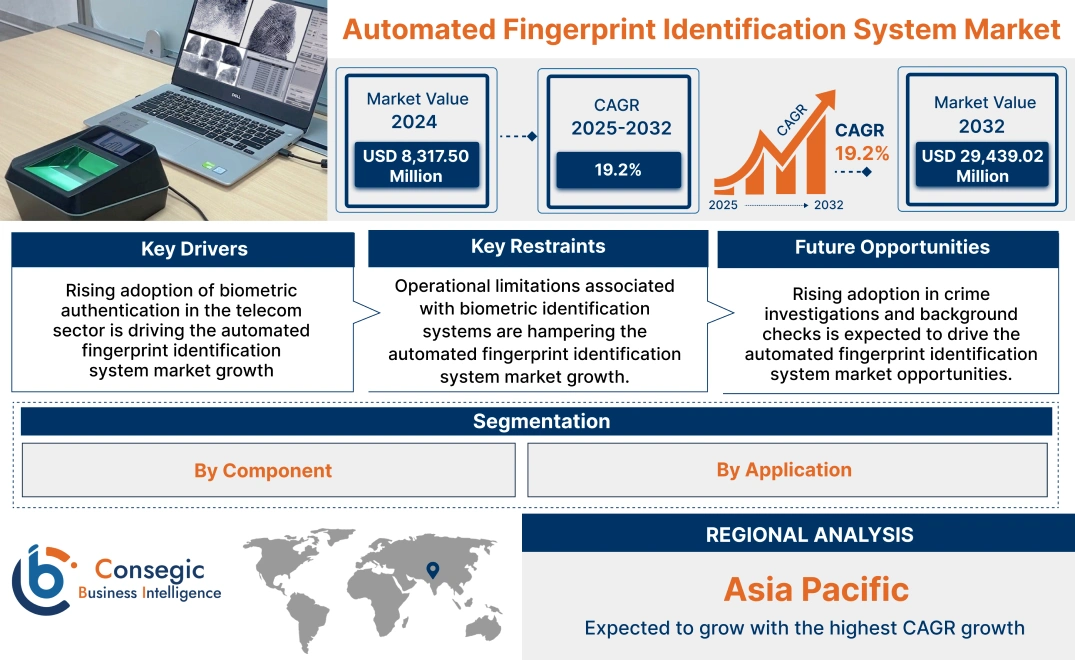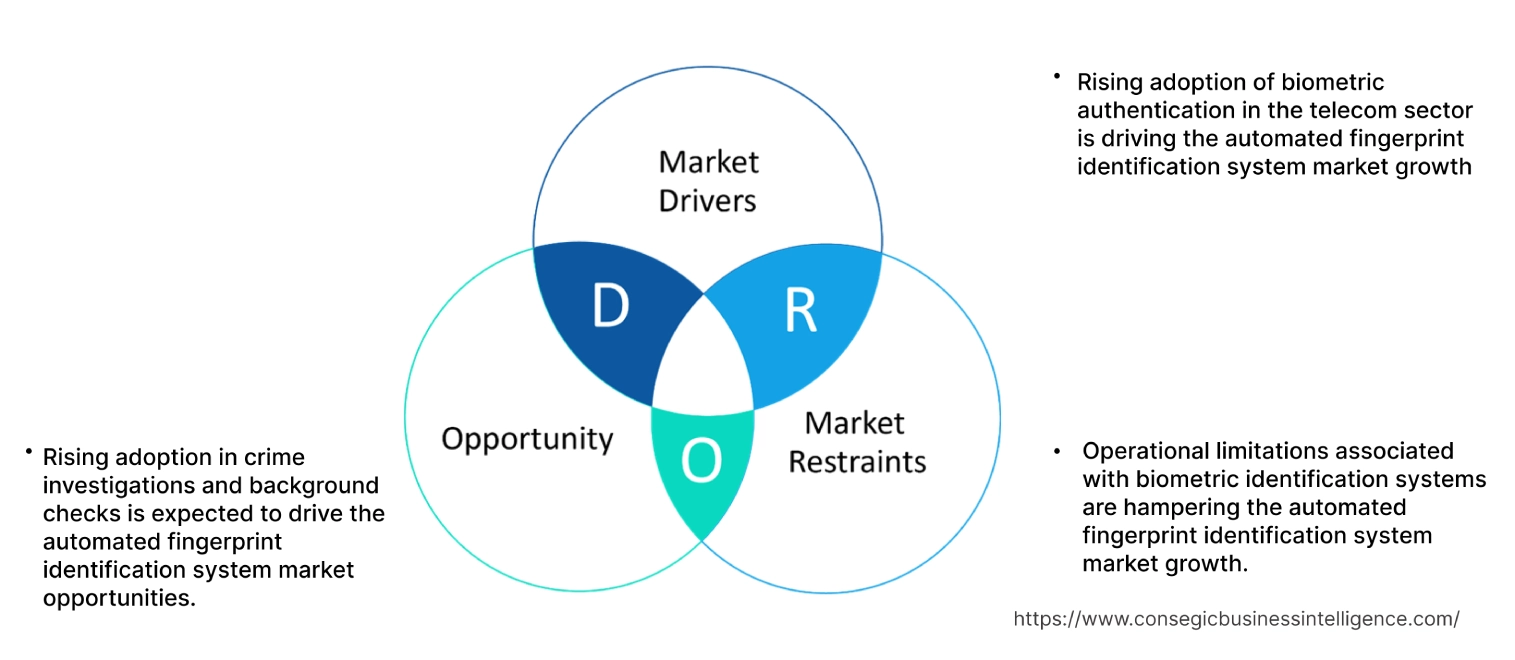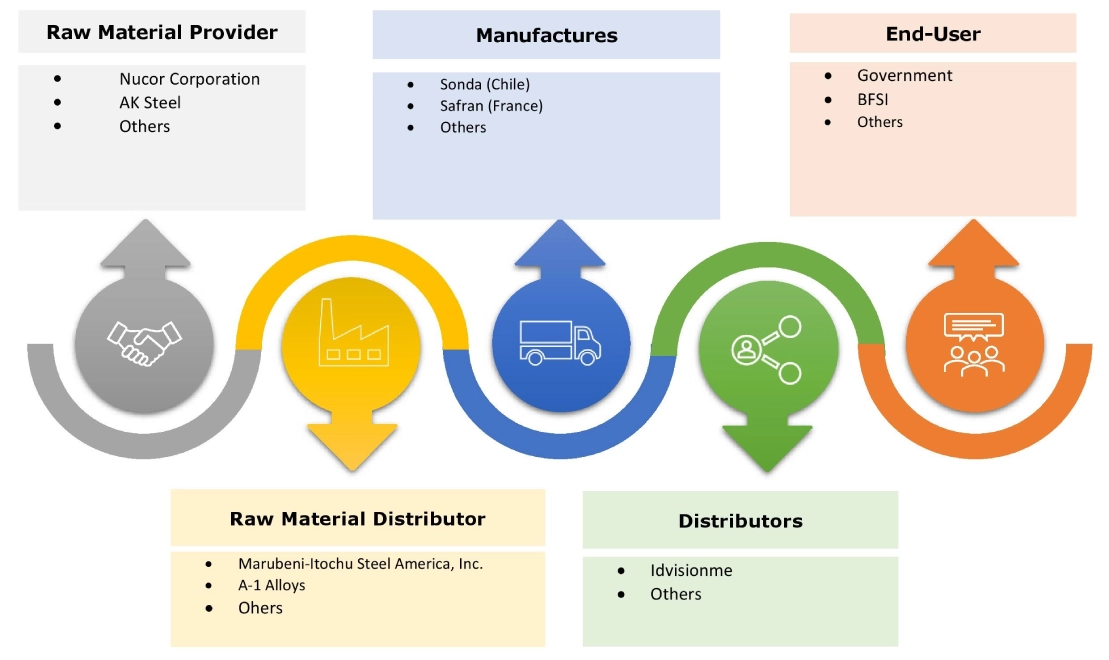- Summary
- Table Of Content
- Methodology
Automated Fingerprint Identification System Market Size:
Automated Fingerprint Identification System Market size is estimated to reach over USD 29,439.02 Million by 2032 from a value of USD 8,317.50 Million in 2024 and is projected to grow by USD 9,602.56 Million in 2025, growing at a CAGR of 19.2% from 2025 to 2032..
Automated Fingerprint Identification System Market Scope & Overview:
An automated fingerprint identification system (AFIS) is a biometric ID solution that uses digital imaging technology to analyze, store, and obtain fingerprint data in a database. Moreover, AFIS generates mathematical representations of obtained fingerprints which are used for quick search and comparison for identification. Further, AFIS is used for criminal investigation by matching the fingerprints of criminals from the database and returning the matching candidates. Additionally, it is used for various applications such as background checks of employees in sensitive sectors, voter registration for election transparency, identifying authenticity of visa applicants, and others.
Key Drivers:
Rising adoption of biometric authentication in the telecom sector is driving the automated fingerprint identification system market growth
In the telecom sector, user identification is important as the telecommunication industry is a security-sensitive industry that requires user authorization for sim card distribution. Moreover, it is used for subscriber verification due to regulatory compliances and for network security to provide personnel access to network infrastructure. Additionally, several countries are opting for advanced methods such as automated fingerprint identification systems for faster user authentication enhancing immigration processes, and improving network service delivery.
- For instance, according to the Telecommunications Act 2023, in India, biometric identification is mandatory for purchasing new mobile sim cards to improve public safety and increase investor confidence in the ease of doing business.
Thus, according to the analysis, the rising adoption of biometric identification in the telecom sector is driving the automated fingerprint identification system market size.
Key Restraints:
Operational limitations associated with biometric identification systems are hampering the automated fingerprint identification system market growth.
Biometric identification systems are associated with various operational limitations such as environmental sensitivity, privacy issues, false rejections, excessive reliance, and others. Moreover, external elements including moisture or dust play a vital role in identifying fingerprints, which causes false rejections to users.
Further, poor quality of fingerprints can lead to misidentification of humans, in turn reducing the reliability significantly, particularly in law enforcement applications. Thus, the operational limitations associated with biometric identification systems are hindering the automated fingerprint identification system market expansion.
Future Opportunities :
Rising adoption in crime investigations and background checks is expected to drive the automated fingerprint identification system market opportunities.
In the law enforcement sector, automated fingerprint identification system plays a huge role in identifying and investigating criminals. Further, law enforcement agencies use biometric identification technology for verifying any fingerprint details from the crime location for quick and accurate identification of criminals. Additionally, automated fingerprint identification software helps in background checks of employees in the public sector to maintain security and government compliance.
- For instance, Aratek offers an automated biometric identification system including fingerprints in its product offerings. It offers various benefits such as analyzing, storing, and capturing fingerprints. The automated fingerprint identification solution is optimized for application in law enforcement agencies for background checks and criminal investigations.
Thus, as per the automated fingerprint identification system market analysis, the rising adoption of fingerprint identification solutions in law enforcement applications is driving the global automated fingerprint identification system market opportunities.
Automated Fingerprint Identification System Market Segmental Analysis :
By Component:
Based on components, the market is segmented into hardware, software, and services.
Trends in the Component:
- There is an increasing trend towards the adoption of fingerprint identification services in the banking and financial sector for improving safety and security.
- Rising utilization of hardware sensors is in trend such as fingerprint readers for monitoring access to high-security applications.
Hardware accounted for the largest revenue share of 52.12% of the total automated fingerprint identification system market share in 2024
- Hardware in automated fingerprint identifying systems includes fingerprint scanners, processors, mobile fingerprinting devices, and others.
- Further, fingerprint scanners help in scanning fingerprints in real-time to analyze and obtain digital fingerprints for authentication purposes.
- It is widely adopted in healthcare, banking, telecom, and other sectors for identity verification, criminal investigation, access management, and others.
- For instance, in May 2022, SecuGen launched the Hamster Pro 30 fingerprint reader, which is suitable for various applications such as immigration, access control, and national ID programs.
- Thus, the rising advancements associated with hardware components such as fingerprint readers for biometric authentication are driving the automated fingerprint identification system market size.
Software is anticipated to register the fastest CAGR during the forecast period.
- Software consists of the database for storing and retrieving fingerprint records and algorithms for extracting fingerprint data with high speed and accuracy.
- Further, the software helps in live scanning and extracting fingerprints for verifying possible matches from the database with the highest score.
- For instance, in March 2023, Innovatrics launched Innovatrics ABIS, a software that supports all modalities including fingerprints for auto-capturing of fingerprints with real-time assessment.
- According to the analysis, the rising advancements in fingerprint identification software are driving the automated fingerprint identification system market trends.
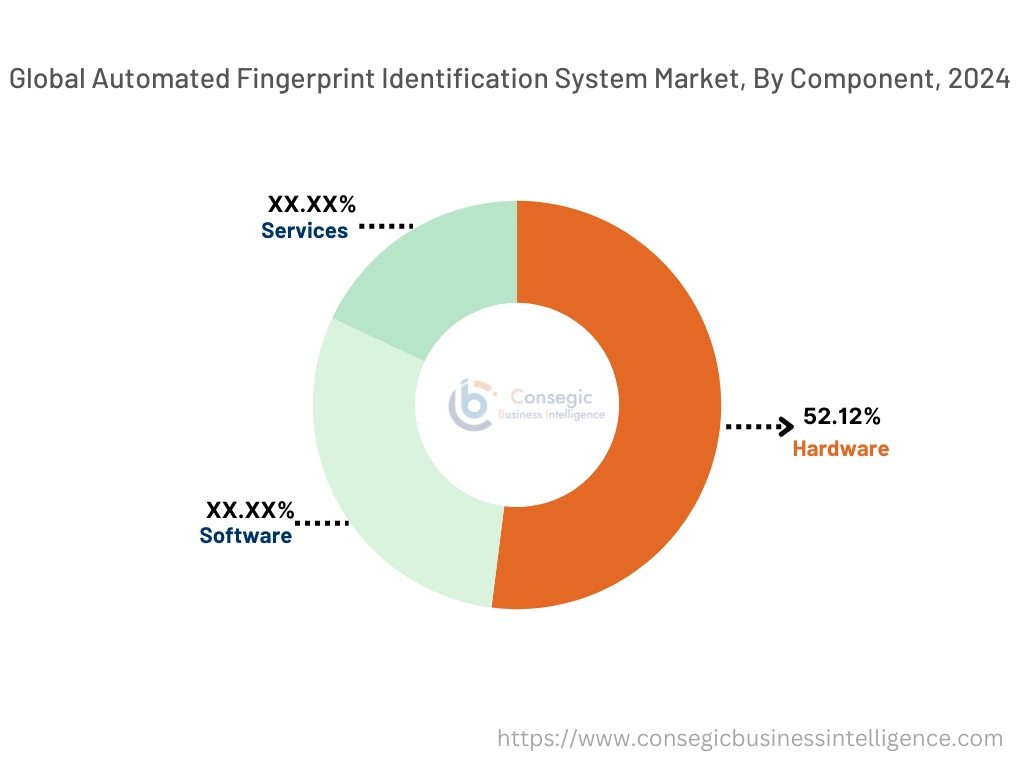
By Application:
Based on the application, the market is segmented into law enforcement, government & public sector, banking and financial services, telecommunication, and others.
Trends in the Application:
- There is an increasing trend towards the adoption of fingerprint identification systems in the telecommunication sector to identify users for providing new sim cards to the users.
- Increasing utilization of fingerprint identification systems in law enforcement for identifying criminals, immigrants, and national ID systems.
Banking and financial services accounted for the largest revenue share in the total automated fingerprint identification system market share in 2024.
- The banking and financial sector requires a robust security system for handling sensitive user data and dealing with a significant number of transactions.
- Further, AFIS technology is secure and safe for user identification and authentication, which significantly reduces the risks of fraudulent transactions.
- For instance, PayU launched FlashPay, which is a safe and secure method for verifying identity using biometrics such as fingerprints before making any credit card transactions.
- According to the analysis, the rising adoption of fingerprint authentication in the banking and financial services sector is driving the automated fingerprint identification system market trends.
The government & public sector is anticipated to register the fastest CAGR during the forecast period.
- Governments are digitizing their essential operations by modernizing systems and implementing reliable biometric solutions such as fingerprint identification, for human identification.
- Further, it enhances security and accuracy in citizen identification during natural disasters, fraudulent activities, criminal identification, and others.
- Additionally, it is widely used in national ID systems to verify the eligibility of a significant number of applicants for government welfare schemes.
- For instance, in December 2024, The National Crime Records Bureau implemented NAFIS (National Automated Fingerprint Identification System) in all Indian districts to identify and verify criminals.
- According to the analysis, the rising utilization of fingerprint identification solutions in the government & public sector is driving the automated fingerprint identification system market.
Regional Analysis:
The regions covered are North America, Europe, Asia Pacific, the Middle East and Africa, and Latin America.
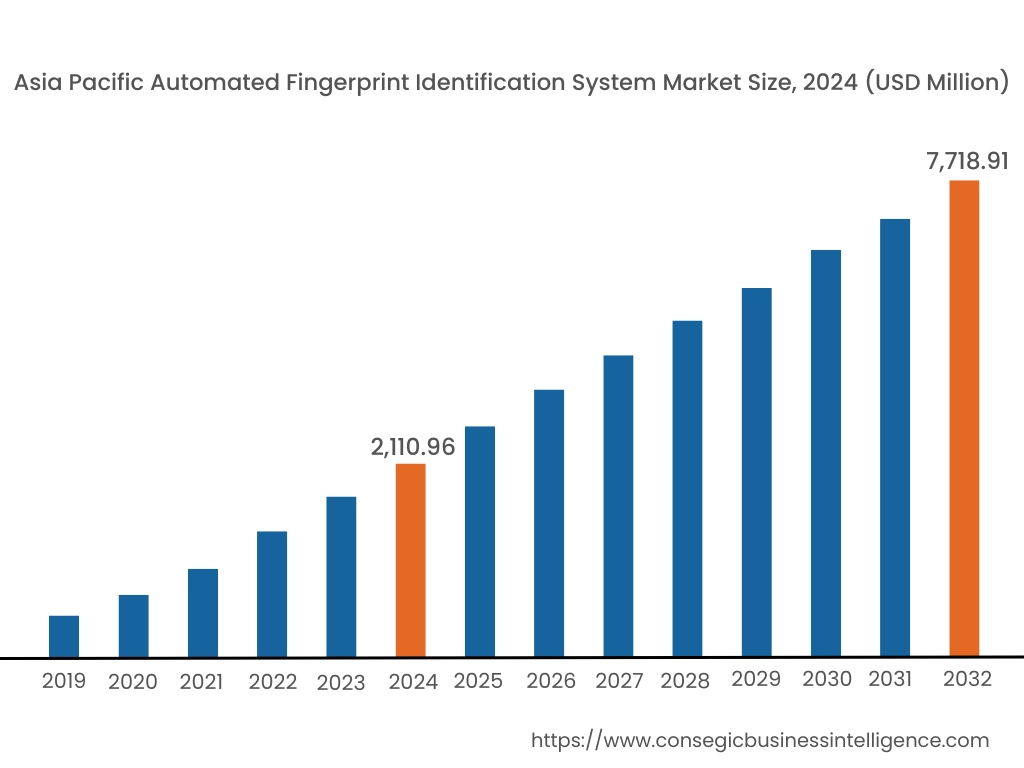
Asia Pacific region was valued at USD 2,110.96 Million in 2024. Moreover, it is projected to grow by USD 2,443.83 Million in 2025 and reach over USD 7,718.91 Million by 2032. Out of this, China accounted for the maximum revenue share of 35.4%. As per the automated fingerprint identification system market analysis, there is an increasing adoption of biometric identification systems, particularly in countries such as China, India, and Japan, for providing advanced features in the government & public sector, banking and financial services, and others. The rapid development and growing investments in the telecommunication sector are accelerating the automated fingerprint identification system market expansion.
- For instance, in March 2022, Bank of Baroda launched its new branch in Udhampur, Jammu and Kashmir. This is further driving the adoption of a fingerprint identification system to verify customers for opening new bank accounts and authenticating employees before providing access to the systems, thereby, propelling the market growth in the Asia-Pacific region.
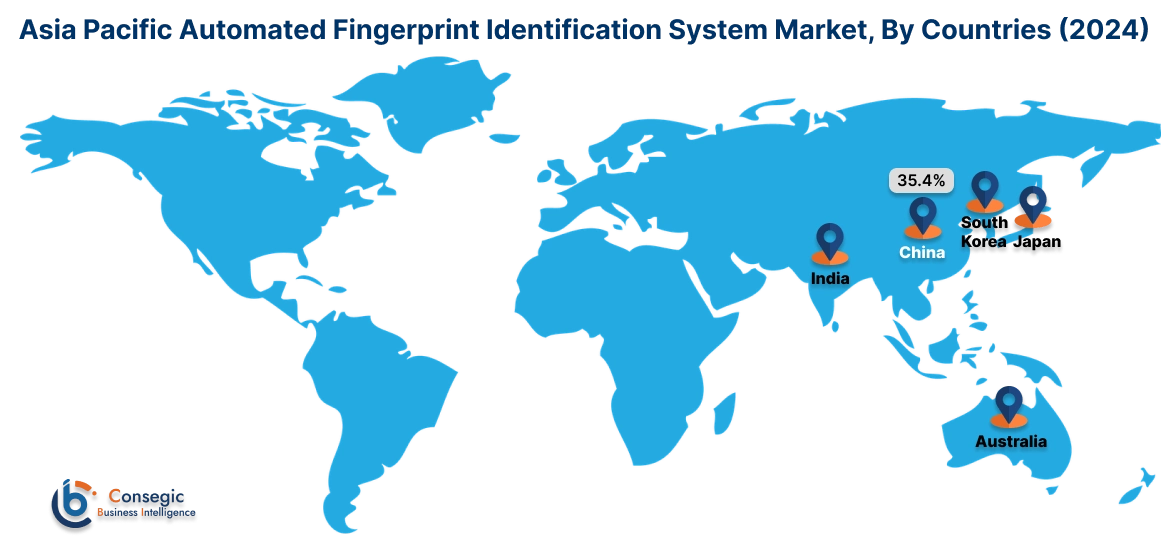
North America is estimated to reach over USD 10,394.92 Million by 2032 from a value of USD 2,938.31 Million in 2024 and is projected to grow by USD 3,392.14 Million in 2025. In North America, the growth of the automated fingerprint identification system industry is driven by the rising demand for advanced solutions in modern banking and financial services, government operations, and others. Rising trends for digitizing banking solutions are also driving market growth. Further, increasing advancements in government operations for identifying citizens are massively contributing to growth in automated fingerprint identification system market demand.
- For instance, in October 2024, Santander launched Openbank in the U.S. to expand its consumer banking businesses across the country. This is further driving the adoption of fingerprint identification systems to verify customers as well as banking employees for accessing financial services, which in turn is driving the market in North America.
The regional analysis depicts that the rising number of illegal immigrants in Europe has increased investments in improving security, which is in turn driving the automated fingerprint identification system market demand in Europe. Further, as per the market analysis, the primary factor driving the market growth in the Middle East and African region includes increasing investment in digital infrastructure such as biometric identification systems for improving overall digital & IT infrastructure. The rising demand for modern identification systems for improving public safety in airports, public places, and others is driving the market demand in the Latin America region.
Top Key Players and Market Share Insights:
The automated fingerprint identification system market is highly competitive with major players providing services to the national and international markets. Key players are adopting several strategies in research and development (R&D), product innovation, and end-user launches to hold a strong position in the global automated fingerprint identification system market. Key players in the automated fingerprint identification system industry include -
- M2SYS Technology (US)
- NEC Corporation (Japan)
- Safran (France)
- Morpho SA (France)
- DERMALOG Identification Systems GmbH (Germany)
- IDEMIA (France)
- 3M (US)
- FUJITSU (Japan)
- HID Global Corporation (US)
- Sonda (Chile)
Recent Industry Developments :
Partnerships & Collaborations:
- In November 2023, IDEMIA collaborated with INTEROL and provided an improved multi-biometric identification system including fingerprint identification for performing police investigations.
Automated Fingerprint Identification System Market Report Insights :
| Report Attributes | Report Details |
| Study Timeline | 2019-2032 |
| Market Size in 2032 | USD 29,439.02 Million |
| CAGR (2025-2032) | 19.2% |
| By Component |
|
| By Application |
|
| By Region |
|
| Key Players |
|
| North America | U.S. Canada Mexico |
| Europe | U.K. Germany France Spain Italy Russia Benelux Rest of Europe |
| APAC | China South Korea Japan India Australia ASEAN Rest of Asia-Pacific |
| Middle East and Africa | GCC Turkey South Africa Rest of MEA |
| LATAM | Brazil Argentina Chile Rest of LATAM |
| Report Coverage |
|
Key Questions Answered in the Report
How big is the automated fingerprint identification system market? +
The automated fingerprint identification system market was valued at USD 8,317.50 Million in 2024 and is projected to grow to USD 29,439.02 Million by 2032.
Which is the fastest-growing region in the automated fingerprint identification system market? +
Asia-Pacific is the region experiencing the most rapid growth in the automated fingerprint identification system market.
What specific segmentation details are covered in the automated fingerprint identification system report? +
The automated fingerprint identification system report includes specific segmentation details for components, applications, and regions.
Who are the major players in the automated fingerprint identification system market? +
The key participants in the automated fingerprint identification system market are M2SYS Technology (US), NEC Corporation (Japan), IDEMIA (France), 3M (US), FUJITSU (Japan), HID Global Corporation (US), Sonda (Chile), Safran (France), Morpho SA (France), and DERMALOG Identification Systems GmbH (Germany).
